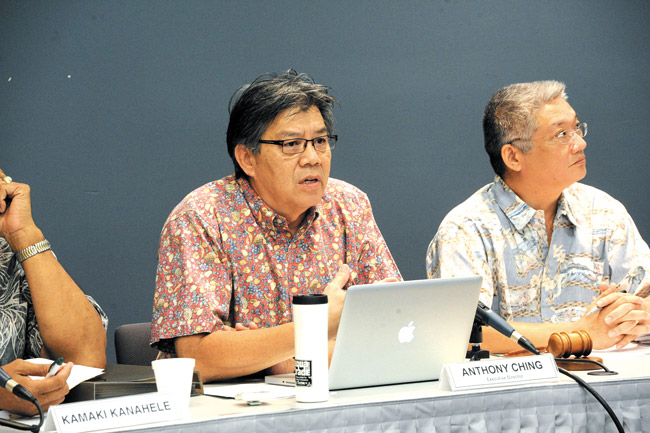Whither Kakaako, Whither The HCDA?

Anthony Ching, executive director of Hawaii Community Development Corp. speaks at a hearing on the proposed 650-foot super tower for Kakaako to be built at 690 Pahukaina St. At right is chairman Brian Lee | Honolulu Star-Advertiser / Craig T. Kojima photo
In the past year, I’ve heard Tony Ching’s presentation on Hawaii Community Development Authority’s (HCDA) master plan for Kakaako on three separate occasions: before an audience of planners and planning students, on Insights on PBS Hawaii, and before a seminar of Honolulu business and labor leaders.
Who knows how many times Ching, HCDA’s executive director for the past six years, has given that same presentation? Even he’s probably lost count.
I’ve always been impressed with Ching’s knowledge of the plan, his belief in the urban community it seeks to achieve, and his sheer enthusiasm for the project.
That last is understandable. Kakaako is, in at least one respect, an urban planner’s dream. Only two land owners, Howard Hughes’s Victoria Ward Limited and Kamehameha Schools, claim 110 acres of Kakaako land that’s available for redevelopment. Convincing two developers with local roots to buy into a plan is far easier than persuading dozens of stakeholders to do so.
That said, Ching, a University of Hawaii-trained planner himself, seems to smile less in these first weeks of 2014 than he did a year ago. The reason’s simple. Politics has intruded on his life, HCDA’s master plan and the Authority’s many roles: as Kakaako’s infrastructure developer and its landowner, planner, regulator and property manager.
Not to mention its extraordinarily ambitious mission, laid out on its website: “to ensure that the Kakaako District is invigorated and established as a dynamic urban neighborhood, one which will accommodate a mix of people and a wide spectrum of activities and commerce …
“Housing opportunities are being increased in Kakaako along with parks, open spaces and other recreational activities” in order to create “the most desirable urban place in Hawaii in which people can work, live, visit, learn and play.”
Those “housing opportunities,” including the six 40-story towers that gained HCDA approval last year, roused a torrent of criticism.
Some of it has been of the NIMBY variety, or at least an offshoot of NIMBYism called “don’t block my view.” Those six towers, and the promise of perhaps 20, some even higher than 40 stories in the next few years, have folks drawn to low-rise Kakaako worried:
“Mildred, is that a new high-rise going up across the street? Oh no, Mildred! It is!”
Others question how many local residents will be able to avail themselves of Kakaako’s new housing.
Ching insists that the new towers will include both “up-scale and workforce” housing. But HCDA’s math and that of scores of opponents who’ve attended the Authority’s meetings don’t match.
Kakaakoans who accept the science of global warming also take pause. They argue that much of HCDA’s planned “vibrant, mixed-density neighborhood” will be under a foot of water before the end of the 21st century.
Others hold that Kakaako’s infrastructure will be insufficient to absorb a forecast tripling of the neighborhood’s population by 2030, despite Mayor Kirk Caldwell’s assurances that it will.
The list of critics and their criticisms goes on – and on.
Elected politicians listen. Majority Leader Scott Saiki represents Kakaako in the state House of Representatives. He gave legislative voice to criticism of HCDA in a package of seven bills, ranging from a one-year moratorium on development in Kakaako to a limitation on the height of new towers. The moratorium and two other bills failed to emerge from House Water and Land committee. Four others did.
Tony Ching may be breathing easier. But smiling? I doubt it.
dbboylan@yahoo.com





